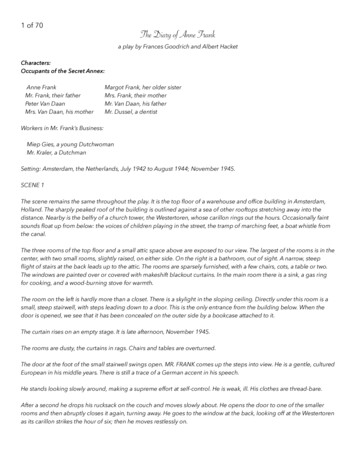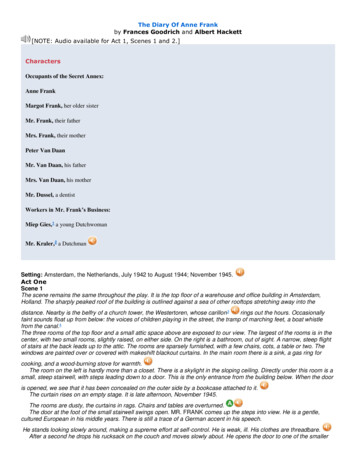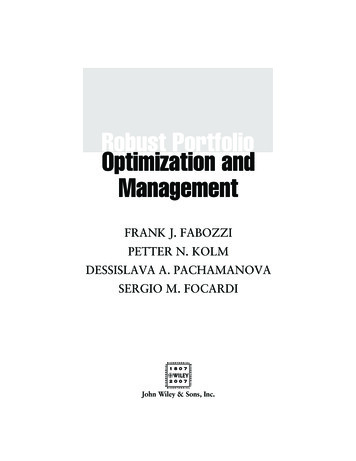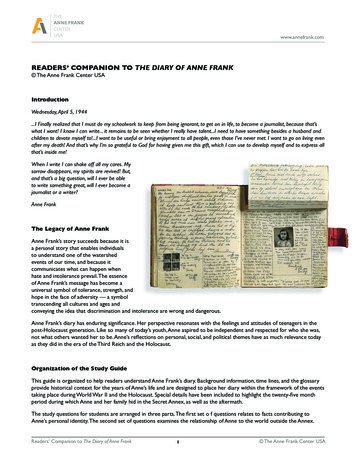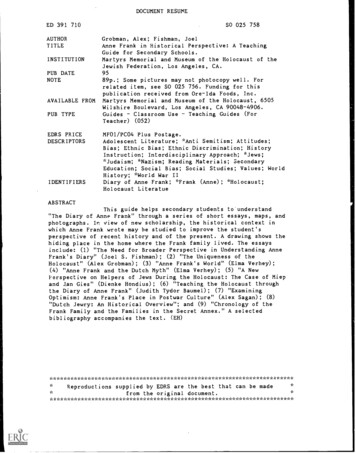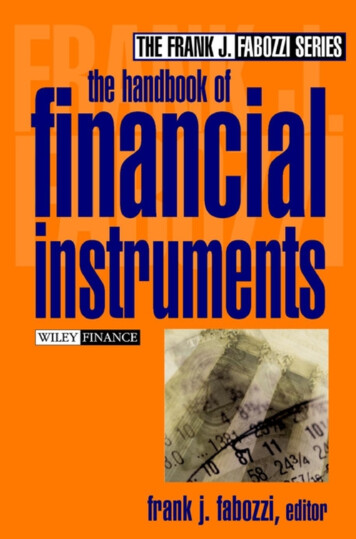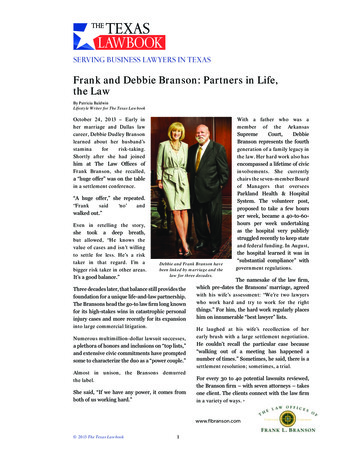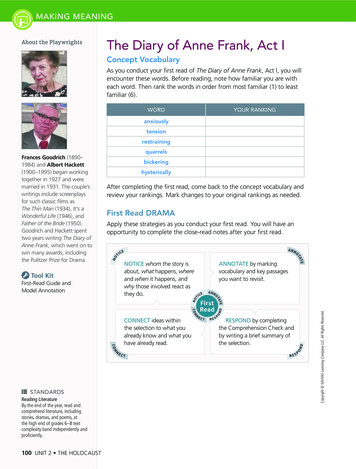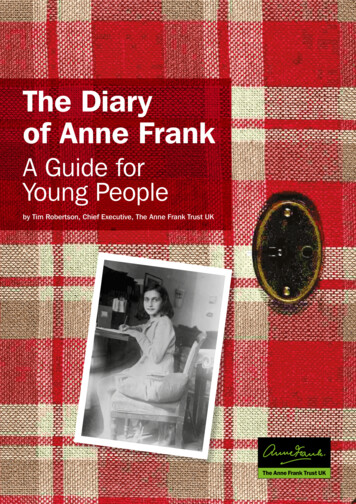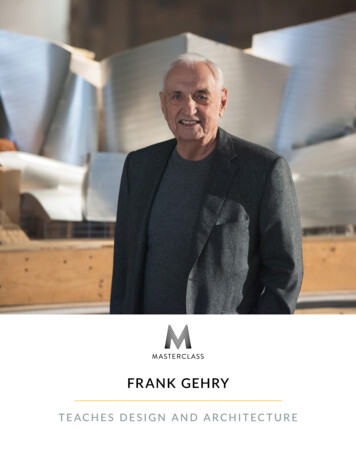
Transcription
FR ANK GEHRYTE ACHE S DE SIGN AND ARCHITEC TURE
ABOUTFRANK GEHRYFrank Gehry was born in 1929 and raised in Canada until he immigrated to Los Angeles,California, in 1947. Frank graduated with a Bachelor of Architecture degree from the University ofSouthern California in 1954. From 1969 to 1973, Frank designed a furniture line called Easy Edges.The curved, swooping forms of his chairs, all constructed from corrugated cardboard, foreshadowthe movement he wanted to express in future designs like the Walt Disney Concert Hall in LosAngeles and the Dancing House in Prague. An accomplished master, Frank has won many awards,chief among them the Pritzker Architecture Prize in 1989 and the Presidential Medal of Freedom in2016.FR ANK GEHRY2
INTRODUCTIONA B O U T T H I S WO R K B O O KThe MasterClass team hascreated this workbook as a supplement to Frank’s class. Eachchapter is supported here witha review and opportunities totake your learning further.M A S T ER C L A S S CO M M U N I T YThroughout, we’ll encourageyou to discuss elements of theclass and your training withyour classmates in The Hub.You can also connect with yourpeers in the discussion sectionbeneath each lesson video.A S K E TC H B O O KThis will be your go-to formatfor visual notetaking. Sketchout your impressions,responses, and any ideas thatcome to mind watching thelesson videos. You should alsocontinue to use your sketchbook throughout the class torecord your creative process.SUGGESTED READINGBefore you dive in, we have a few reading recommendations: Building Art: The Life and Work of Frank Gehry by Paul GoldbergerThe Death and Life of Great American Cities by Jane JacobsModern Architecture Since 1900 by William J.R. CurtisThe Story of Art by E. H. GombrichWays of Seeing by John Berger (or watch the BBC television series of the same name!)Poetics of Space by Gaston BachelardHistory of Modern Architecture by Sir Bannister FletcherFR ANK GEHRY3
2.ON CREATIVITY“You should enjoy findingyourself, and you shouldenjoy expressing yourself.You’re not killing anybodyor hurting anybody, andthey can reject you, andthey will. Believe me,they will. And you gottajust keep doing it.”—Frank GehrySU B C HAPTER S Find Your Creative Signature Healthy Insecurity Find Creativity Everywhere Dealing With NegativityCHAPTER RE VIE WFrank advises you to be yourself and develop your creativesignature. Your signature should be recognizable, different fromyour colleagues’, and should reveal something about you. As Franksays, your signature is “a prime example of the visual impact ofyour own persona.”At the end of the first semester of his second year of college,Frank’s professor told him architecture was not the professionfor him and suggested that he find another field of study. Frankignored the advice. Many years later, Frank ran into theprofessor, who admitted his mistake. When someone says you’renot cut out for something, assess your critic and what he or shestands for, and decide if you agree. Harness the strength thatcomes from his or her statement. It will keep you going.Always be curious, and let architecture open the door to differentsubjects, such as philosophy, literature, and music. Regardless ofyour profession, apply the self-propelled creativity required of anarchitect to your field or daily life.Study the great architects—Le Corbusier, Zaha Hadid, LinaBo Bardi, Borromini, Bernini, Michelangelo, Brunelleschi, OscarNiemeyer, Louis Kahn, Julia Morgan, Ludwig Mies van der Rohe,Eliel Saarinen, Louis Sullivan, Frank Lloyd Wright—but rememberthat it is your conscience, your talent, and your mind that has aresponsibility to others.TAKE IT FURTHER Frank used to visit public schools and construct block citieswith children. Find an opportunity like this for yourself oryour firm, or pioneer one. Think about the kind of people youwould like to support, what you’d like to show them aboutarchitecture and its potential to inspire a love of mathematicsand the arts, and the kinds of projects you’d like to complete.Share your thoughts with your classmates in The Hub. Read more about Frank’s philanthropic endeavors at publicschools.FR ANK GEHRY4
2.ON CREATIVITYTAKE IT FURTHER CONT. If you’re academically inclined, read this article on thephilosophy of architecture and a chapter on Kant in The MissedEncounter of Radical Philosophy with Architecture, or any of thesetexts: On the Art of Building in Ten Books by Leon Battista Alberti(1485).“The Eiffel Tower” by Roland Barthes (1979).“The Work of Art in the Age of MechanicalReproduction” by Walter Benjamin (1936). (Werecommend the whole essay, but Section XV focuses onarchitecture.)“Function and Sign: Semiotics of Architecture” byUmberto Eco (1968).“Building Dwelling Thinking” by Martin Heidegger(1951).Critique of the Power of Judgment by Immanuel Kant(1790).Ten Books on Architecture by Vitruvius (15 BCE).The Pleasure of Finding Things Out by Richard P. Feynmanand Jeffrey Robbins (1999)FR ANK GEHRY5
3 4 .DESIGN PHILOSOPHY,PARTS 1 AND 2CHAPTER RE VIE W“We’re living in a kind ofimperfect messiness. Soit’s kind of logical that wewould express that when[we] build.”—Frank GehrySU B C HAPTER S “Not Knowing Cheers the Knowing” Design for Real Life Imagine You Are the Audience Transfer Your Feelings Focus on Expression Not Symmetry Respect Your Neighbor Consider Common Materials Begin Your Process on Paper No Small Projects Knowing When You’re Done Don’t Dine Out on Your SuccessesFrank sees the world as a collision of thoughts representedthrough buildings, music, and art that is not properly expressedthrough the simplicity of the neat, clean squares of Modernism.The white boxes that are the architectural hallmarks of thetwentieth century—while beautiful—can be unfriendly. Franksees this kind of architecture as overpowering to the lives of thepeople who live in them and instead advocates for buildings andinteriors that serve as a background for life.The mission of an architect is to design something that one wouldwant to be a part of, something one would want to visit and enjoyin an attempt to improve one’s quality of life. Architecture isthe quest to transfer the feelings of humanity through inertmaterials. You want to create a feeling or emotional response thatis not only comforting but enlightening. Work to see asymmetryas Frank does: democratically. The freedom asymmetry providesan architect is similar to the freedom of human expression;endless curiosity will lead to limitless solutions and ideas whichmay at first seem threatened by the restrictions of economics.Know, though, that there is always freedom to work within theselimitations. The same advice applies to creative roadblocks.Your goal as an architect is to engender an uplifting and positiveexperience through your design. Frank attempted this with theWalt Disney Concert Hall, creating a space in which a reciprocalrelationship between the feelings of the musicians and those ofthe audience could flourish. He consciously tried to understandwhat would make performers and listeners feel comfortable.Frank also put thought into the surroundings of the WaltDisney Concert Hall, as he wanted the building to relate to theneighboring structures. You should always attempt to do the samewith your designs.You shouldn’t rely on your prior successes. Respect the motivationand pressure a deadline places on you and always keep in mindthat there’s no such thing as a small project, so put your besteffort forward in everything you plan and construct.FR ANK GEHRY6
3 4 .DESIGN PHILOSOPHY,PARTS 1 AND 2TAKE IT FURTHER In this chapter, Frank recalls seeing a statue of a charioteerfrom 500 BC in Delphi. While studying this piece of art,he was deeply moved by the transference of humanity hefelt radiating through the sculpture. Look at the DelphiCharioteer; then think of an artwork or building that had asimilar effect on you. Draw it in your sketchbook, and shareyour drawing and a description of your experience seeing it forthe first time with your classmates in The Hub.FR ANK GEHRY7
5.GENERATINGIDEASCHAPTER RE VIE W“If you’re relentless, youcan make the fly that stopsthe train.”—Frank GehrySU B C HAPTER S Explore the Crazy Ideas Repeat Yourself Creative Block Question Your Eureka Moments A Typical WorkdayDesigning a building is like playing jazz. You improvise, yourespond, and you work intuitively to create something. The ideaevolves and things happen, and you go with it. Trust it, don’toverthink it, and allow it to take you somewhere new.The job of an architect is sometimes fraught with anxiety, soembrace the struggle and take risks. Have a firm idea for yourproject from the start, but also create the logic for it as you go.For example, Frank mentions brick and the kinds of connotationsit has. Try to use it and other materials in new and exciting wayspeople haven’t seen before. Because they are familiar with thematerial, they might be more accepting of its use in innovative,creative designs that will emerge as you theorize throughoutthe project. Run with your ideas and forget about creative block.Keep trying ideas and designs, allowing them to naturally evolve.Creative block is merely an excuse you make in order to delay theprocess.FR ANK GEHRY8
6.FRANK’SINSPIRATIONCHAPTER RE VIE W“You have to be curiousand search out these greatworks from the past. Not tocopy them, but to at leastunderstand what [they]meant.”—Frank GehrySU B C HAPTER S Learn From Other Masters Contemporary Inspirations Be True to YourselfIn this chapter, Frank speaks about the fine artists andarchitects that inspire him. While studying city planning atHarvard, he spent time with people that worked in the office ofrenowned architect Le Corbusier. A show of Le Corbusier’spaintings was particularly formative for Frank. Looking at thepaintings, Frank realized that it was possible for architects towork out building and structural ideas through media other thanstandard blueprints.In his early days of practicing architecture in Los Angeles, Frankwas involved in the local art scene. He became close to artistsand was inspired by their hands-on approach. Frank also citesMichael Heizer, Gordon Matta-Clark, and Robert Smithson asinspirations. If you see a painting and can’t forget it, its influencestarts on you there. If you subconsciously start riffing on it,even if you aren’t familiar with the work or the artist, trust theinstinct and explore it.Never stop being influenced by the work of others. Frank reads,studies, and observes many sources and mediums, and believesthis encourages and engages one in his or her architectural work.There is no substitute for it. Be curious and seek out great worksfrom the past. Don’t copy them but rather try to understandthem.TAKE IT FURTHER Read about Le Corbusier’s Notre Dame du Ronchamp. Read Le Corbusier’s Towards a New Architecture. Explore the works of Michael Heizer. Check out Splitting by Gordon Matta-Clark, a piece thatinspired Frank. Watch a short film that documentsMatta-Clark’s process. The philosophy of earthworks artist Robert Smithsoninfluenced Frank. Read Smithson’s selected writings.FR ANK GEHRY9
6.FRANK’SINSPIRATIONTAKE IT FURTHER CONT. Frank and his friend Irving Lavin, a professor of arthistory, look at works of art together during their travel. Planan architectural or fine art tour. What buildings, structures,and artworks have you always wanted to see? What sketchbooks and materials will you take with you? How will you usethese experiences to generate your own ideas? Set flight alertsso you can be notified of cheap airfare and make your trip areality! Identify five to six buildings that you absolutely love. Usingthe library, museums, online archives, and galleries,identify two pieces of art that you think could have inspiredyour selected buildings. Think of when the building wasdesigned, and try to seek out works of art from the same timeperiod. Share your images and notes in The Hub.FR ANK GEHRY10
7.DESIGNOBSTACLESCHAPTER RE VIE W“There are so many rules.There’s a lot of room forcreativity outside that, youknow. You can meet allthose constraints and stillmake architecture out ofit. “—Frank GehrySU B C HAPTER S 15% Identify What Is Beyond YourControl Mistakes Are Important TooThere are many rules that govern architecture, from the codesof the building department, to budget restrictions, to the desiresof the client. However, there’s a lot of room for creativity outsideof these mandates. You have 15% freedom to make your art. Viewyour constraints as opportunities.Throughout your career, you will constantly have small victoriesand make small mistakes. You must keep moving ahead, learningfrom the mistakes, and building on the successes. There willbe continual evaluating, re-evaluating, missed and seizedopportunities, and bad and good advice. The people involved inprojects are like pieces of a puzzle that you have to put together.At the end, everything should fit perfectly.TAKE IT FURTHER Share with your classmates in The Hub an experience in whichyou dealt with creative disagreements or issues with funding.What compromises did you reach? How did you make yourvoice heard? If you’re not a practicing architect, share astory in which similar problems occurred at work or schooland explain how you came to a resolution. Read Building Codes Illustrated or Building ConstructionIllustrated by Francis Ching.FR ANK GEHRY11
8.EXPRESSINGMOVEMENTCHAPTER RE VIE W“We live in a society whereeverything is moving—cars, planes, trains. Thatmessiness has given a sortof humanity to everything. Iwas interested in expressingmovement with inertmaterials.”—Frank GehrySU B C HAPTER S From Inspiration and Intention. .To RealizationExpressing movement with inert materials is a tradition that goesback to the Greeks with the Elgin Marbles, continued throughBaroque Italy with Bernini and others, and influences architectsto this day—especially Frank. He has always been fascinated withthe folds of dresses and costumes in portraits, and urges you tospend more time looking at the folds than the faces.Notice the objects you continually draw in your sketchbooks, asthese things might lead to something great. In a lecture Frankgave, he told his listeners that the Greek temples they wereemulating were anthropomorphic, and that if they wanted tolook to the past, they should go back 300 million years to fish.Following that statement, Frank began drawing fish in hissketchbooks constantly, but never intended to build them. Hissketches of buildings that resembled fish attracted a fashionhouse in Italy, and they invited him to make a fish sculpture for afashion show in Rome.Frank considered the 35-foot-long wooden fish a piece of kitsch,but it opened up opportunities for him; later, the Walker ArtCenter displayed one of his lead and copper fish sculptures. Thisalso inspired Frank to play with curved forms, which led to theexterior designs of the Guggenheim Museum Bilbao, as well as theWalt Disney Concert Hall. Frank sees the sense of movement inthese buildings as a replacement for the dead-end of minimalismand decoration.TAKE IT FURTHER Learn about the Elgin Marbles, also known as the ParthenonMarbles. Learn about the history and formal elements of Gian LorenzoBernini’s sculpture The Ecstasy of Santa Teresa. Notice Bernini’sattention to the folds of the fabrics that drape the figures, aswell as the statue’s expression of movement. Take a look at Hiroshige’s woodblock print series Uo-zukushi (AShoal of Fishes). Read Michelangelo Drawings: Closer to the Master by HugoChapman.FR ANK GEHRY12
9.CREATING WITHYOUR CLIENTCHAPTER RE VIE W“It’s all about makingpeople happier, richer,friendlier, so they stopbuilding fences and [we]stop separating ourselves.”—Frank GehrySU B C HAPTER S Understand Your Client’s Needs Respect the Budget Decide If It’s the Right Projectfor You Create and Experiment With SiteModels Explore Materials That Fit BothBudget and Design Vet Technical Issues as You Go Keep Your Client EngagedThroughout the Entire ProcessFrank encourages you to be conscious and accepting of the factthat clients have feelings and needs that can change from day today. Think of yourself as the captain of a ship, navigating watersthat can change from placid to stormy at any given moment; youmust steer accordingly and remain open to the changes yourclient might make.Internalize everything pertinent to your client, from the locationof their home, to the contents of their art collection, to the sizeof their family. Also be cognizant of the different cultures of yourclients. Frank finds it helpful when talking to clients about theirvalues to have a pencil in hand so he can sketch freely as theyconverse. Try thinking out loud with your clients and drawing asyou go in order to create a visual, spatial response to their words.For Frank, these sessions occur over many visits and take severalforms—a visit to the site, a visit to the house the clients live in,and sometimes a dinner at their favorite restaurant. Taking thetime to get to know your client will lead to a higher satisfactionrate and more jobs as they recommend you to others.Remember that square footage always has a price tag attached.You need to discuss this reality with your client and inform themabout the cost of more luxurious materials. Talk through issuesof sustainability as well, and be sure to reconcile your economicswith your client’s economics throughout the entirety of theproject. Don’t make assumptions about your client’s willingnessto spend based on their financial situation. Similarly, leaveyourself open to the preferences of clients that might not haveoccurred to you; a feature of the land that you originally intendedto highlight may be a component your client would ratherdiminish.FR ANK GEHRY13
9.CREATING WITHYOUR CLIENTYou must also know yourself. As an architect, you naturally bringyour aesthetic to every project. Frank has learned to recognizewhen his fingerprint doesn’t match a project. In these instances,he suggests another architect better suited for the job. Be sure toloop in technical experts throughout a project. Frank’s method isto have them look over his work, keeping an eye out for anythinghe might have overlooked from a technical standpoint. This helpshis team avoid large problems that could delay a project.Remember, you are attempting to enrich the life of your clientwith a project, so always have this objective in mind.TAKE IT FURTHER In this chapter, Frank discusses a residential project for anIranian client whose idea of a family home differs from thatof people from other cultures. Learn how homes vary acrossregions of China, read about the changes in Japan’sresidential architecture after WWII, and see the differencesbetween America’s domestic architectural designs.FR ANK GEHRY14
10.TAKE AWAYS FROMTHE WALT DISNEYCONCERT HALLCHAPTER RE VIE W“I was looking for what Ialways look for—thehumanity of it.”—Frank GehrySU B C HAPTER S Research What Works Prototyping Adding Movement andHumanity to the Exterior Listen to Your End User(Aand Become Their Hero) Knowing When It Works:The Joy of ArchitectureFrank discusses the buildings that inspired the Walt DisneyConcert Hall and the reasoning behind his design choices. Therelationship between the orchestra and the audience was animportant factor to Frank. He looked to the main hall of theBerliner Philharmonie for inspiration, the layout of which makesthe audience feel as if they’re connected with the performers. Itsconcrete floor, unpainted pipe rails, and raw quality are engaging.The Concertgebouw in Amsterdam also influenced the design forthe Walt Disney Concert Hall; Frank adopted its feature of seatsplaced behind the orchestra.The original plan for the concert hall was stone. Frank liked thequality of light that stone reflects at night, a soft glow evocativeof the historic buildings of Europe. In the end, however, it was 5million dollars less expensive to use metal, so the powers that beinsisted that the main material be changed. Frank attempted toconvey a sense of movement with the wave of the metal, insteadof the flatness of an inert box.Using a model, Frank explains the thought process behind thedesign, explaining piece by piece the reasoning for the placementof the roof, bathrooms, staircases, and the like. Frank and histeam used a one to ten scale model. They put figures in it, filled itwith nitrogen, and then played Mozart inside the model in orderto test the acoustics. This method was devised by the Japaneseacousticians involved with the project and was very effective,allowing the team to critically evaluate the space and compare itssound to that of other concert halls.Frank also recounts memories from before the hall was revealedand on its opening night. An emotional moment occurred whenthe first violinist came to play unaccompanied Bach in theunfinished hall. Frank, his son, and the conductor of theorchestra grabbed each other’s hands and wept at the beauty ofthe sound. On opening night, Frank had his eye on the bassplayer, because his instrument had not been done justice inChandler Hall, the venue in which the orchestra had previouslyplayed. During the first few bars, the bassist gave Frank a thumbsup. For Frank, these kinds of experiences within the professionare the most rewarding.FR ANK GEHRY15
10.TAKE AWAYS FROMTHE WALT DISNEYCONCERT HALLTAKE IT FURTHER Experience the Berliner Philharmonie, and view the interiorof the Concertgebouw in Amsterdam, both of which inspiredFrank’s design for the Walt Disney Concert Hall. Also look upthe New World Symphony in Miami, the Pierre Boulez Hall inBerlin, the Millennium Park in Chicago, the Boston SymphonyHall, the Musikverein in Vienna, the Great Theater in Ephesus,Turkey, and the Greek Theater in Taormina, Sicily. Take a guided tour of your local auditorium or symphony.Notice the acoustics of the space—how your voice carries,how footsteps echo. Write down your impressions in yoursketchbook. Treat yourself to an evening of music orperformance in the same space. Notice how the theater’sacoustics differ when the theater is filled with music oramplified voices. Do you feel removed from the orchestra oractors? What would improve the space?FR ANK GEHRY16
11.TAKE AWAYS FROM8 SPRUCE STREETCHAPTER RE VIE W“For this building, we [were]trying to come up with alanguage that resonatedwith the older buildingsaround us. And we werealso trying to get somefeeling into the buildingwith the curtain wall. Thatit would have a humanityto it that those facelessbuildings that are all overthe world don’t have.”—Frank GehrySU B C HAPTER S Begin With the Basic Program The Art of the Curtain WallFor 8 Spruce Street in New York, Frank and his team asked theirclient to hire the architect behind all the standard apartmentbuildings in the city. That architect made a model of the cheapestand most straightforward structure he would build for any client,which provided a base upon which Frank built.One of the most important elements of a tower is the curtain wall,or the exterior skin of the building. Frank wanted to play with theconcept of bay windows because of the feeling they give abuilding’s inhabitant; their quality of space makes one feel as ifone were outside and closer to the world. There was economicrationale behind the bay window, too, as it is an element thatsomeone might pay extra for.Instead of placing each bay window in the same position, whichwould have created a straight visual line on the exterior, Frankand his team varied each window’s location in an attempt tomake the curtain wall look like fabric blowing in the wind. Thisfeature gives the building a feeling of movement and a humanquality, which people often point out to Frank.TAKE IT FURTHER Read the New York by Gehry brochure and fact sheet, andexplore the official website. Read what residents of 8 Spruce Street have to say about theirbuilding. Read the New York Times’ architecture review of 8 SpruceStreet. Read the Harvard Business School report on 8 Spruce Street. Read about the technology behind 8 Spruce Street.FR ANK GEHRY17
12.NEIGHBORHOODAND CONTEXTCHAPTER RE VIE W“You.begin to see a senseof humanity that workswith the cultural centerthat’s different than withthe financial district.They’re two differentthings.”—Frank GehrySU B C HAPTER S Design Elements That ReferenceYour Neighbors Design for Human Interaction Firstand Neighborhood Scale SecondFirst and foremost, places and buildings are for people. A buildingcan respect its neighborhood if the architect attempts to have itspeak to the buildings that surround it.The scale of a building is dictated by economics and zoning—thevalue of the land upon which the edifice stands, the marketingof the building as a workspace or dwelling and the parametersattached to each. While a building will be held to certainstandards regarding height and accessibility, Frank contends thatthere is still much freedom within these restrictions. It’s up toyou to discover and explore this freedom.When designing the Grand Avenue Project, which included retailspaces, apartments, condos, and a hotel, Frank had the sense ofdowntown Los Angeles’s humanity in mind at all times; inparticular, he had to respond to the Walt Disney Concert Hall,which is directly across the street. He opted for a collection ofbuildings mid-range in height in order to create dialogue with thevaried scale of the concert hall.Frank’s decisions were based on human scale, and byincorporating a cluster of buildings with a courtyard and multiplelandscaping opportunities for the Grand Avenue Project, Frankmade the space user-friendly for many types of activity.TAKE IT FURTHER In this chapter, Frank discusses the human scale’s influenceon 19th century architecture. Learn more about this subject.FR ANK GEHRY18
13 .MATERIALS ANDPROTOTYPINGCHAPTER RE VIE W“You.get focused onsomething you want toaccomplish, and then youjust doggedly figure outhow to make [that material]work.”—Frank GehrySU B C HAPTER S Research and Play With theLatest Materials Test How New Materials PlayWith Light Get Creative With Materials ThatSuit Your Budget From brick to glass, Frank is always playing with materials andthe aesthetic and energy issues that are specific to them. Reallyexplore materials and put the effort into researching them,because this will lead to breakthroughs. Don’t be afraid toabandon a material if it does not fit the original concept whenrealized. Spend time with those in charge of the different systemsand ask them about materials that can be used given your budget,then convey this budgetary information to your client. FollowFrank’s golden rule for materials: if the light paints on it, you’veused the right material.Show Clients What Can Be DoneTAKE IT FURTHER Explore new possibilities in architectural materials. Discoverthe potential of carbon fiber, see how architects and designersare elevating plastic to unprecedented levels, and learn abouta Cal Poly San Luis Obispo assistant professor’s invention ofa brick that sucks pollution from the air. Do you use concretein your designs? Educate yourself about the environmentalimpacts of this material and its substitutes. Do you refrainfrom using wood in your buildings? Open your mind to thisnatural material’s potential by listening to a podcast orparticipating in a webinar sourced by reThink Wood.FR ANK GEHRY19
14 .RESIDENTIALPROJECTSCHAPTER RE VIE W“In the first few months ofworking with a client on abuilding, you get to knowthem, you get tounderstand what it isthey’re looking for. Whythey want to do this andwhy they’re taking theirhard-earned savings tospend on it. I mean youhave to respect all of that.That’s a big deal.”—Frank GehrySU B C HAPTER S Ask Questions and Listen Keep the Client Involved Be ParentalThe first few months of working with a client are key. During thistime, you get to know them and what they’re looking for.Respect their time and money. Planning and constructing a housecan be challenging, as oftentimes a couple contracts the work,and they inevitably argue, leaving you in the middle of a domesticfeud. You should visit the house where your clients live andobserve their collections and the objects they treasure to get abetter idea of the space that would best suit them. Frank usesblock models when he begins a house or residential project thatinclude the site and its surroundings. He uses the blocks, whichrepresent the scale of rooms, to explore spatial relationships withhis clients.Know that your clients’ main concerns will be aboutmoney, schedule, and technical things like leaking and longevityof materials, but be sure to discuss with them the aesthetics ofthe neighborhood and landscape in which they live. Obtaininformation about closets, bathrooms, openness versus privacy,colors and materials they dislike, and even things as seeminglyinsignificant as which way they like their bed to face. It’sbetter to know their preferences, however trivial, before you begindesigning. Remember that this is a very personal process, so keepit light and fun for your clients, but also be parental: take chargeand convince them that you can complete their project within their budget. Encourage them, talk with them, and convey tothem that you’re on top of every element.TAKE IT FURTHER Take a look at some of Frank’s residential projects: Gehry Residence in Venice, California Robert Benson Residence in Calabasas, California Davis Studio and Residence in Malibu, California Schnabel House in Los Angeles, California Norton House in Venice, CaliforniaFR ANK GEHRY20
15 .BUSINESS“You don’t have to be superrich to do this stuff. I thinkyou have to have the heartand the will and thetenacity to not fold underpressure and understandyour responsibility in thegame.”—Frank GehrySU B C HAPTER S “Business Model” Have Financial Integrity Be a Master Builder Prove Your Design Can Be Built Fight WasteCHAPTER RE VIE WFrank has run a succe
A SKETCHBOOK This will be your go-to format for visual notetaking. Sketch out your impressions, responses, and any ideas that come to mind watching the . Walt Disney Concert Hall, creating a space in
